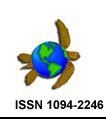 |
 |
Submitting Manuscripts
The submission of a manuscript is taken to imply that the material is original, and that no similar paper has been or will be submitted for publication elsewhere. Submission of a manuscript will also be taken to imply that all the named authors have seen and agreed to the submitted version of the paper, that all who are listed as providers of personal communications have agreed to their inclusion, and that all requisite permissions for the use of material (from previously published sources or made available electronically) are supplied with the final submission.
Manuscripts submitted to Contemporary Herpetology (CH) must be divided into a number of files to facilitate processing by our editors and reviewers as well as to expedite their conversion to web documents. The body text should be in a single file (.doc, .docx, .txt, .rtf), all tables should be clearly formatted and sent as text or MS Excel (.xls) files, and all images/ figures should be sent as individual files and not imbedded in the text. Authors should submit all manuscript files as attachments to an e-mail cover letter. Arrangements can be made with the Editor regarding an excessively large submission. Unless other arrangements have been made with an Associate Editor, all manuscripts should be sent to a the Editor. Necessary file conversions will be made prior to forwarding the submission to an Associate Editor.
Once a manuscript is accepted, authors are required to submit copies of a signed consent to publish form. At this time, the manuscript will be formatted for the Web and the author(s) will then have the opportunity to proof the manuscript. Upon approval by the author(s), the manuscript will be published on CH and its mirror sites.
Conventions for Submitted Material
Text formatting
Do not embed any non-text resources (including equations) within your text. All papers must be in English. Write with precision, clarity, and economy; use the active voice and first person. A style sheet is in preparation, until ready, it is suggested that authors follow the most recently accepted manuscripts. Although many text attributes are set by individual browsers when viewing web documents, submissions to CH should follow the following conventions in order to facilitate the review process.
Underlining/Italicization
Italicize scientific names and the symbols for all variables
and constants except Greek letters in the text. Symbols should be italicized
in the illustrations to match the text. Do not underline text.
Greek Characters
Greek characters are not supported as symbols by most graphical
browsers at present. Please write out in full (e.g., alpha, beta) all Greek
characters that occur within the text of your manuscript. Greek characters are
permitted within equations, which must be submitted as separate graphics files.
Tables
Tables must be submitted in a format that preserves their
layout, whether they are tab- or space-delimited. The Rich Text Format (RTF)
is a useful general-purpose file format in which to submit tables.
Literature Cited
Citations should be spelled out in their entirety. Page numbers
of books should be not be included. The authors' names should be capitalized
and all but the last name abbreviated.
Citing Original Descriptions
If an authority is provided for a scientific name (e.g. Sonora semiannulata Baird & Girard 1953) the entire reference must be provided in the Literature Cited section of the manuscript (Baird, S. F. and C. Girard. 1953. Catalogue of North American Reptiles in the Museum of the Smithsonian Institution. Part I - Serpents. Smithsonian Micellaneous Collections. 49. xvi + 172 pp.)
Units
Use the International System of Units (SI) for measurements.
Consult Standard Practice for Use of the International System of Units (ASTM
Standard E-380-93) for guidance on unit conversions, style, and usage. When
preparing text and graphics, note in particular that SI requires (1) the use
of the terms mass or force rather than weight, (2) when one unit appears in
a denominator, use the solidus (/), but for two or more units in a denominator,
use negative exponents, and (3) use a capital L as the symbol for liter.
Internet Formatting
Given the ephemeral nature of the Internet outside the directories
of Contemporary Herpetology, the stability of external links cannot be guaranteed.
Thus, authors may not include links to other Internet resources outside the auspices of CH in their articles.
Technical inquiries about manuscript submission and formatting should be directed to the Editor.